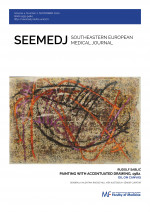Croatian Translation and Linguistic Adaptation of the Short Assessment of Health Literacy for Spanish Adults (SAHLSA-50)
DOI:
https://doi.org/10.26332/seemedj.v4i2.139Keywords:
Croatian language; , health literacy; , SAHLSA-50; , translationAbstract
Introduction: Population needs health literacy (HL) in order to understand health-related topics. Short Assessment of Health Literacy for Spanish Adults (SAHLSA-50) could be a high-quality tool for assessing HL in adults. Unlike questionnaires in the English language, which are not easily modifiable for Croatian, translation of SAHLSA-50 from Spanish into Croatian could be an appropriate choice. There are no similar questionnaires to assess HL in Croatian to date.
Aim: To translate SAHLSA-50 into Croatian using a validated procedure and to adapt it linguistically, so that it could be used in the Croatian-speaking area to measure HL in the Croatian population.
Material and Methods: SAHLSA was developed for the Spanish-speaking population by Lee et al. It consists of 50 items and is based on multiple choice questions. A score between 0 and 37 suggests that the respondent has inadequate HL. After the protocolized translation process (translation/back-translation), the final version of the Croatian translation of SAHLSA-50 was produced, after we introduced several changes that do not represent a direct translation of the Spanish items. Most of the changes were made because of a cultural difference in common use or in the meaning of the term.
Conclusion: SAHLSA-50 was translated and adapted into Croatian using the standard translation/back-translation procedure. The Croatian version will now be available as an important part of epidemiological and clinical studies, as a useful tool for evaluating the levels of HL in the Croatian-speaking population. Validation of the translated Croatian version in practice would be the next step.
Downloads
Published
Issue
Section
License
Copyright (c) 2025 Southeastern European Medical Journal

This work is licensed under a Creative Commons Attribution-NonCommercial-NoDerivatives 4.0 International License.



